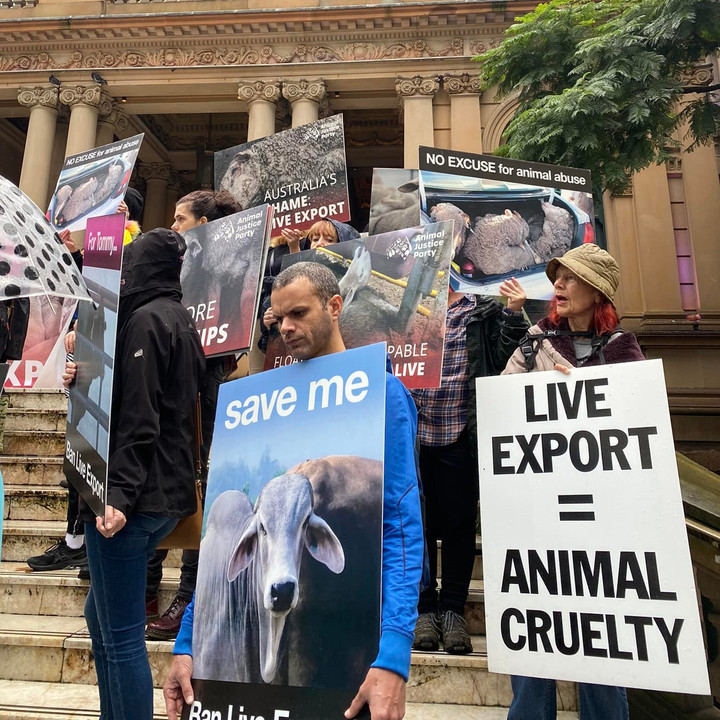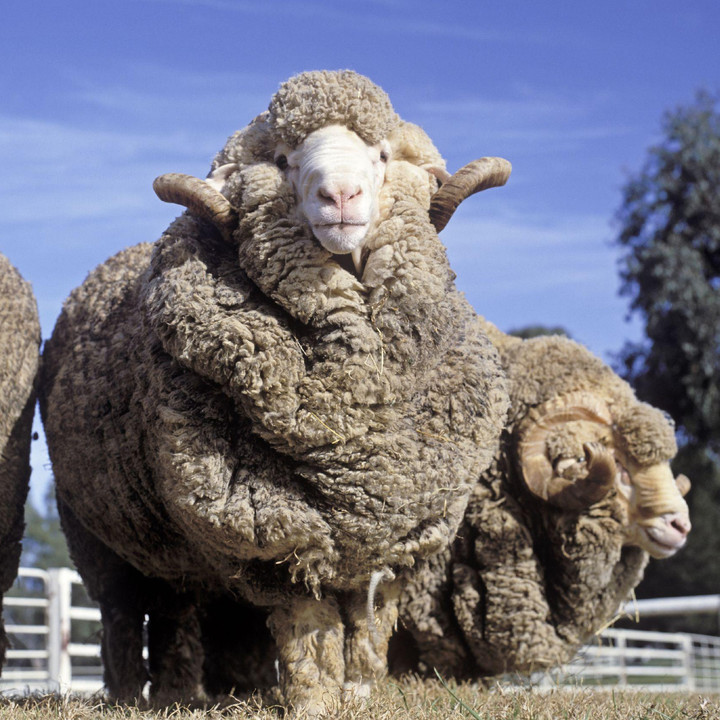
Live Exports in Australia
Despite growing unpopularity, Australia continues to be one of the world's largest live exporters.
In 2021, according to the Department of Agriculture, Fisheries and Forestry, Australia live exported over 1.37 million animals overseas, meaning Australia continues to be one of the world's largest live exporters, despite growing opposition to the live exports trade within the Australian public.
In 2021, Australia live exported
The Plight of Animals in Live Export
Animals destined for slaughter overseas face a grim future. They spend days or even weeks, travelling on the open seas. If they survive the stressful journey, they are then cruelly slaughtered under substandard conditions.
This Is How Animals in Live Export Suffer.
Note: Any advertisements that may appear during the viewing of this video are unrelated to FOUR PAWS. We assume no liability for this content.
This is heartbreaking, tragic, and happening every year around the world and in Australia. Ending our role in live exports must be a clear goal for Australia.
A Modern Chronology of Live Exports in Australia
Federal Government under Albanese has committed to phasing out live sheep exports
After successful campaigning by animal activists and dwindling sheep export numbers, the Albanese Government plans to phase out the live sheep trade, but the industry and opposition government want to keep it going.

Live export kicks off again in South Australia, after four-year hiatus.
Terrible news after confirmation that animals are once again being live exported from Port Adelaide after a four-year break with indications cows are being exported for breeding and production purposes. There are also fears cows are being exported while pregnant.
Federal Department of Agriculture reverses plan to unwind the summer live exports
Success for animal welfare as the Federal government decided to maintain the summer ban period on live sheep exports to some of the hottest Middle East destinations.
Federal Government under Morrison plans to resume summer live animal exports
Shocking plans by the Federal Government to wind back Northern Summer Live Sheep Export Ban triggers controversy. FOUR PAWS as part of the Australian Alliance for Animals campaigned against this winding back. Read more here.
Live sheep exports ban for northern summer
A limited ban was introduced, halting the export of sheep to the Middle East during the northern hemisphere’s hottest summer months
60 Minutes broadcast shocking footage from inside an Australian live sheep export vessel
60 Minutes exposed horrifying footage where 2,400 Australian sheep died of heat stress onboard the Awassi Express as temperatures soared in the voyage to the Middle East.

ABC Four Corners continues to expose cruel live export: 'Another Bloody Business'
A year after exposing the cruelty endured by Australian cattle live exported to Indonesia, ABC Four Corners exposed the suffering endured by 21,000 sheep live exported from Australia to Pakistan. Watch the investigative video here.
An explosive exposé by ABC Four Corners ‘A Bloody Business’
An explosive expose of the cruelty inflicted on Australian cattle exported to the slaughterhouses of Indonesia, which depicts traditional rope slaughter, use of slaughter restraint boxes, failure to stun cattle prior to slaughter as well as the kicking and hitting of animals. There is a strong public response to the incident. Watch the video here.
Fast Facts on Live Exports in Australia
What you should know about this cruel industry
Why are animals exported alive to foreign countries?
Intensive farm animal production has led to a specialisation in breeding and fattening farms, where Australian cattle, goats and sheep are then live exported to slaughterhouses overseas. The centralisation of slaughterhouses in cheaper foreign countries, and the aim to minimise production costs have led to the demand for Australian animals sent alive for slaughter.
FOUR PAWS therefore calls for a ban for live animal exports.
What is wrong with sending animals to foreign countries for slaughter?
Most live exported animals are sold for immediate slaughter once they reach destination ports. The way the animals are slaughtered in the countries Australia exports do not meet best practice for animal welfare, align with Australian standards for slaughter, and most often, breach World Organisation for Animal Health standards.
There is no stunning before slaughter, which results in severe violence being used to make the animals defenceless before and when the throat is cut. Cruel and callous practices in an attempt to make the animals helpless before the slaughter cut, such as stabbing their eyes and cutting their leg tendons, have been documented regularly and published in veterinary journals. The suffering endured before the animal is finally dead lasts up to 30 minutes.
What is the controversy behind live sheep exports?
In particular to live sheep exports, sheep suffer extremely poor welfare onboard these ships.
Over the past decade, whistleblowers have given us disturbing insight into a previously un-seen industry. We have seen horrific footage of animals packed so tightly, they begin to trample those no longer able to stand. Even so they stand in piles of their own excrement, wide eyed and panting, unable to breathe through ammonia-heavy air and being slowly ‘cooked alive’ in 40-degree heat onboard these transport ships. Those who do survive the shipping process then disembark in hot temperatures, to be sold off for slaughter, where the slaughter practices do not meet Australian standards.
Why are animals exported alive?
Exporting and importing countries want to make the most profit from the animals. Importing countries profit from the hides, the milk, the calves, and the meat. Some of the countries claim to aim at building their own breeding population. But in fact, no stable breeding population has been built up so far in the importing third countries even though trade has been going on for decades.
In reality, many of the animals are slaughtered soon after arrival because the feed resources are not available in most countries. High yielding cows imported from Australia need high quantities of water and feed to stay healthy. This is mostly not available in the importing third countries, leading to cows being slaughtered soon. Ritual slaughter without stunning is also a major reason for importing live animals4.
How are animals being exported?
97% of Australian farmed animals are predominantly live exported by sea. The remaining 3% by air.
Which animals are being live exported from Australia?
In 2021, the DAFF issued livestock export permits for cattle, sheep, goats, alpacas, and buffaloes. Prior to 2019, Australia used to live export camels in small numbers.
Why were these animals exported?
They were exported primarily for immediate slaughter (50%) and as feeder animals prepared for eventual slaughter (41%). A small proportion were exported for breeding purposes (9%).
Which Australian state is the biggest live exporter in Australia?
In 2021, Western Australia is the largest live exporter in Australia, responsible for 57% of Australia's total live exported animals. They are followed by Northern Territory (21%), Queensland (13%), Victoria (7%) and New South Wales (1%). South Australia had a four-year hiatus of live exports, but since November 2022, sadly, their live export industry has since resumed.
How do animals suffer in live transport?
Animals destined for slaughter are often transported for several days or weeks in disastrous conditions. Numerous animals sustain serious injuries and many animals suffer and die during the journeys. This is an expected part of this trade, with allowable mortality rates set for voyages depending on the animals being exported. Animals destined for breeding purposes also suffer from terrible conditions on these journeys that often last several days and even weeks.
In addition, many animals are bred, reared and slaughtered in different locations, resulting in several journeys that an animal has to undergo during their life.
- The maximum loading density is exceeded and does not allow animals to rest in a normal position. This is well documented with sheep exports, with footage showing sheep so tightly packed onto decks that they cannot sit at all, but are pressed tightly against one another for the entire duration of the voyage, up to three weeks.
- Insufficient height inside vehicles transporting them to and from vessels, especially during the transport of cattle in double-decker truck.
- Unsuitable loading ramps (e.g. too steep, slippery).
- Transport vehicles lacking suitable equipment for feeding and watering (esp. when transporting young, un-weaned animals).
- Transport of animals being unfit for transport (sick animals and those with broken limbs), transport of highly pregnant animals.
- Fights between animals originating from different stables within the vehicles.
- Rough handling of animals during loading and unloading, leading to fear and serious injuries of the animals.
- Poorly trained or inexperienced staff, badly paid drivers, reckless driving.
- Missing control posts (resting stations) in third countries to enable legally required resting intervals.
- Temperature limits within the vehicle/vessel exceeding acceptable temperature (> 30°C and < 5°C), the animals suffer from heat and cold, numerous animals die of heatstroke or freeze to death.
- Empty or frozen water supply leads to severe suffering and deaths.
- Lack of bedding or any manure removal onboard vessels.
What is the alternative to live animal transports and live exports?
Trade with foreign countries has to shift from live animals to a trade in meat and carcasses and genetic material only. FOUR PAWS is advocating for community-based, restorative and sustainable agricultural practices that promote local farming, rearing and slaughter. Decentralisation of farms and locating abattoirs and slaughterhouses within a short distance from the farms is an important aspect to achieve an end of long-distance transports.
What Is FOUR PAWS Doing?

Public advocacy and education
#BanLiveExports

A stronger voice for animals
LEARN MORE
Source
2. Meat and Livestock Association, State of the Industry Report 2022 - https://www.mla.com.au/globalassets/mla-corporate/prices--markets/documents/trends--analysis/soti-report/2879-mla-state-of-industry-report-2022_d6_low-res_spreads.pdf
3. ABS (Australian Bureau of Statistics)
4. The Guardian, 2020. https://www.theguardian.com/environment/2020/jan/23/how-the-middle-easts-water-shortage-drives-demand-for-live-animal-imports







